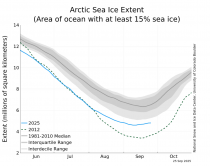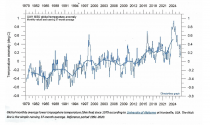By Jim Wallace
The total Arctic Ice Extent’s minimum, which occurs every year in September, was 36% higher in 2025 than its minimum in 2012, which was the lowest ice extent ever recorded by the NSIDC. On September 10, 2025, Arctic Sea Ice Extent likely reached its annual minimum extent of 4.60 million square kilometers (1.78 million square miles). The minimum is based on Advanced Microwave Scanning Radiometer 2 (AMSR2) data from the Japan Aerospace Exploration Agency (JAXA).

Source: NSIDC (National Snow and Ice Data Center)
The NSIDC has only been measuring the Arctic Ice Extent by Satellite since 1978 and only reporting it since 1981. But this data deserves more attention because ice extents are a much better indicator of any Global Warming than the so called Global Average Surface Temperature data - which has been shown to be totally fabricated. Moreover, CO2 and other Trace GHGs have been shown to have not had a statistically significant impact on any of 14 credible Earth temperature data (see: COMMENT ON EPA’S REPEAL OF ITS 2009 GREENHOUSE GAS ENDANGERMENT FINDING: https://thsresearch.wordpress.com/wp-content/uploads/2025/09/comment-on-epa-repeal-of-its-2009-ghg-ef.pdf, page 5, page 14 and page 16.
Moreover, research cited in this Comment (see Page 8) has shown that the Earth’s 14 most creditable temperature data patterns over this relevant time period are each ready explained by Natural Factors, most importantly the solar, volcanic and oceanic activity. The dramatic decline in UAH Lower Troposphere temperature data in 2025 shown below, is due entirely to Natural factors, and would be consistent with this Arctic Sea Ice Extent behavior.



